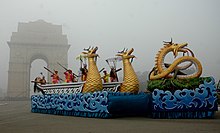Ura Naha Khongjomba and Pidonnu
| The story of Ura Naha Khongjomba and Pidonnu | |
|---|---|
| Folk tale | |
| Name | The story of Ura Naha Khongjomba and Pidonnu |
| Aarne–Thompson grouping | no |
| Mythology | Meitei mythology |
| Country | |
| Region | Moirang, Manipur |
| Origin Date | During the reign of Moilang king Iwang Puriklai Laijing Punsiba (1138–1210)[1] |
| Related | Meitei folklore, Meitei literature |
| Part of a series on |
| Meitei mythology |
|---|
 |
|
|
The ancient legend of Ura Naha Khongjomba and Pidonnu (Meitei: Khongjomba-Pidongnu) is an epic cycle of incarnations of Meitei mythology and folklore from the Moirang kingdom[a] of Ancient Kangleipak (early Manipur).[1] It concerns the love and adventures of the forgotten prince Ura Naha Khongjomba for the beautiful woman Pidonnu.[2][3]
Characters
[edit]Ura Naha Khongjomba (Old Manipuri: Khongchompa; regnal name: Iwang Puriklai Khongjomba) (1210–1263) was the biological son of King Laijing Ningthou Punsiba (1138–1210)[4] of Moirang and Lady Tonu Laijinglembi, but he was born in the house of his foster father, Kadeng Thangjahanba, the second husband of Tonu Laijinglembi.[5][6][7][8]
Pidonnu (Old Manipuri: Pitonnu; also spelled as "Pidonu" or "Pidongnu") was the daughter of a nobleman of Moirang.[5][6][7][8]
Plot
[edit]King Laijing Ningthou Punsiba is unaware that his biological son Khongjomba was born into the house of Kadeng Thangjahanba. Unable to produce any further sons and lacking an heir, he consults his courtiers court and chooses a young man named Nidrām, on the strength of his princely moral standards, to be his successor.[5][6][8]
After Kadeng Thangjahanba dies in the prime time of his life, his wife Tonu Laijinglembi is afraid that her son Khongjomba will come to harm if his true parentage is revealed. She flees with her young son into the hills, seeking asylum in the house of her husband's friend, the chief of Leihou tribe. There she lives until her son grows to manhood. During that time, as planned by God Thangching, the people of Moirang forget about Tonu and Khongjomba, and thus refuse to help them upon their return to the town. Now living in poverty, Khongjomba collects firewood daily for Tonu to sell in the market.[5][6][8]
One day, Khongjomba meets Lady Pidonnu during a game of kang (a traditional Meitei game) played between ladies and gentlemen. Nidrām, the royal heir, becomes immediately jealous. He sends his men to attack Khongjomba, but they are overcome by the powerful Khongjomba. Nidrām thus looks for other ways to harass Khongjomba.[5][6][8]
A special day arrives where the ladies of Moirang participate in a large fishing event at Loktak Lake. It is customary that men were not allowed near the lake on this special day. As Khongjomba wanders around the lake, he is caught and beaten by Nidrām and his men. Tonu runs to King Laijing Ningthou Punsiba to save her son's life. The king remembers that Tonu was pregnant with his child when she left him. Tonu then reveals Khongjomba's true parentage. King Laijing Ningthou Punsiba is surprised and alarmed. Without delay, he crowns his true son Khongjomba as the sovereign of Moirang, and discards the appointed heir Nidrām.[5][6][8]
Later, the two lovers King Ura Naha Khongjomba and Lady Pidonnu are married and live happily ever after.[5][6][8]
See also
[edit]- Akongjamba and Phouoibi
- Henjunaha and Lairoulembi
- Kadeng Thangjahanba and Tonu Laijinglembi
- Khamba and Thoibi
- Khuyol Haoba and Yaithing Konu
Further reading
[edit]- Datta, Amaresh (1988). Encyclopaedia of Indian Literature: Devraj to Jyoti. India: Sahitya Akademi. p. 1303. ISBN 978-81-260-1194-0.
- Gill, Preeti (13 February 2014). The Peripheral Centre: Voices from India's Northeast. Zubaan. ISBN 978-93-83074-65-5.
- Sinha, Biswajit (2008). Contemporary Theatre: East & North-East. Raj Publications. ISBN 978-81-86208-59-5.
Notes
[edit]- ^ Moirang was an independent kingdom in early times, and later became a province of the unified Manipur Kingdom.
References
[edit]- ^ a b "manipur channel >>Moirang Kangleirol ~ E-Pao! News About Manipur". e-pao.net. Retrieved 22 October 2022.
Iwang Puriklai Laijing Punsiba (AD 1138-1210) Kadeng Thangja Hanba - Tonu Laijinglembi; Khongjomba - Pidongnu
- ^ Oinam, Bhagat; Sadokpam, Dhiren A. (2018). Northeast India: A Reader. Taylor & Francis. p. 236. ISBN 978-0-429-95320-0.
Apart from several other works based on the theme of love, mention may be made of the literature coming from the Moirang region of Manipur. A civilization situated on the magnificent Loktak Lake, the culture of the Moirang clan has been noted. Numerous manuscripts of the Moirang region dwell on the theme of love. One of the most popular stories refers to the seven pairs of lovers who are regarded as incarnations of the same souls in different generations or ages. The seven cycles are Akongjamba (hero) and Phouoibi (heroine); Henjunaha (hero) and Leima Lairuklembi (heroine); Khuyol Haoba (hero) and Yaithing Konu (heroine); Kadeng Thangjahanba (hero) and Tonu Laijinglembi (heroine); Ura Naha Khongjomba (hero) and Pidonnu (heroine)...
- ^ Lisam, Khomdan Singh (2011). Encyclopaedia Of Manipur (3 Vol.). India: Kalpaz Publications. p. 588. ISBN 978-81-7835-864-2.
- ^ Shobha, Hemamcha (8 July 2012). "2". Moirang and Ebuthou Thangjing. Reproduced by Shanjoy Mairembam. Archived from the original on 15 October 2022. Retrieved 22 October 2022 – via e-pao.net.
- ^ a b c d e f g Bormani, Sarangthem (2003). Moirang Shaion (in Manipuri). Manipur University Library, Imphal. India: Sarangthem Bormani, Chinga Makha Chanam Pukhri Mapal; Digital Library of India. pp. 590–632 – via Internet Archive.
- ^ a b c d e f g Singh, Ch Manihar (1996). A History of Manipuri Literature. Original from:the University of Michigan. India: Sahitya Akademi. pp. 67, 68. ISBN 978-81-260-0086-9.
- ^ a b "Moirang Ningthourol Moirang and Ebuthou Thangjing Part 6". e-pao.net. Retrieved 22 October 2022.
- ^ a b c d e f g Boamani Singh, Sarangthem (1994). Tonu Laijinglembi (in Manipuri). Manipur University Library, Imphal. India: Sarangthem Bormani Singh; Digital Library of India – via Internet Archive.
External links
[edit]- "Manipuri Literature in History 4". e-pao.net. Retrieved 22 October 2022.
